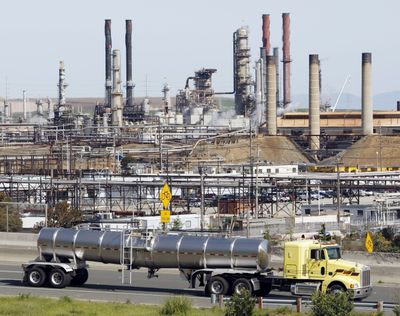Study: Refiners operated when gas prices spiked
Emissions data indicate work during plant outages

WASHINGTON – West Coast gasoline price spikes in May and October were widely blamed on refinery outages, but new research to be released at a California hearing today shows that refiners continued to produce gasoline in periods when the public was told the contrary.
The information, shared exclusively with McClatchy Newspapers, comes from Oregon-based McCullough Research, which combed through thousands of pages of environmental documents to conclude that refineries were in fact operating during supposed outages and maintenance shutdowns.
Specifically, the report alleges that in May, at a time when Royal Dutch Shell’s Martinez, Calif., plant was reported to be down for maintenance for two weeks, it appears to have been making gasoline for at least half that time. That conclusion is reached from state environmental documents showing nitrogen oxide emissions had returned to normal at the refinery a full week before it was reported to have come back on line.
Similarly, Chevron’s Richmond, Calif., refinery was reported down for maintenance for two weeks in May, but emissions data suggests the refinery never ceased operation.
The research also concludes that gasoline inventories actually were building in May during a time in which West Coast motorists paid at least 50 cents more per gallon than the national average. This inventory building, evident in data from the California Energy Commission, happened even as four refiners were supposedly down for some portion of May.
At the time, media reports, citing analysts and industry officials, blamed the price hikes on outages and maintenance shutdowns.
But the shutdowns, which energy companies said had been planned long in advance, have not traditionally happened in May, the research showed, in part because it is a high-demand month for gasoline usage.
The October price spike, which mostly affected California, was shown by the research to be about 66 cents higher per gallon of gasoline than should have been the case based on historical patterns of oil prices and gasoline inventories.
“This is an environment where market power, defined as the ability of a few producers to set prices outside of market forces, is likely to exist,” Robert McCullough said in a report that he will formally present today during a hearing in Sacramento on California’s refineries. His access to state regulatory data was aided by a push from the office of Sen. Dianne Feinstein, D-Calif.
The hearing will be held by the state’s Senate Select Committee on Bay Area Transportation. And though California is the focus, the conclusions carry national implications, especially because they highlight how little real information on pricing is publicly available, or even available to regulators.
“It certainly does not prove collusion among the principal suppliers, since specific data by refineries is difficult to procure,” McCullough’s report said. “However, the data does suggest the need for an investigation on a refinery-by-refinery level.”
And that’s just what Sen. Maria Cantwell, D-Wash., is calling for. Cantwell is planning to send a letter to the Justice Department and the Obama administration’s much-maligned task force on oil prices, calling for a refiner-by-refiner investigation into pricing during this year’s spikes.
“We expect these markets to be policed, and I shouldn’t have to rely on a researcher in Oregon to know there’s a problem,” said Cantwell, who for much of the past decade has pressed for greater transparency and regulation of oil markets.
Following the 2001 collapse of energy trader Enron, the Federal Energy Regulatory Commission was empowered to probe and publish price data, she noted, calling for something similar for oil and gasoline markets.
“I don’t think gasoline prices are so inconsequential that you couldn’t have the Department of Justice going refinery to refinery and make sure these markets are properly policed,” Cantwell said. “In electricity, at least we know that the FERC is a policeman on the beat.”
The price spikes in May affected the states of California, Oregon and Washington, while October’s price spike was felt mainly in California. May’s West Coast spike was partly blamed on a Feb. 18 fire at BP’s Cherry Point refinery in Washington. October’s California spike was explained as partly a market reaction to an Aug. 6 fire at Chevron’s Richmond refinery.
What’s odd about those spikes is that normally prices shoot up during events that lead to supply shortages. But the spikes came many weeks after the events at the refinery, and McCullough’s research suggests that contrary to a shortage, supply was growing.
The Western States Petroleum Association speaks for the region’s refiners and declined to comment on the specifics of McCullough’s report until actually seeing the data when presented Thursday. McCullough declined to share it with the association on the grounds that refiners have the same data he has since it was shared with environmental regulators.
“People have made all manners of claims and this industry has been investigated dozens of times in the past 20 years, and each time the changes in prices have been found to be because of the dynamics of supply and demand, and not the result of any market manipulation or anti-competitive conduct,” said Tupper Hull, spokesman for the association.